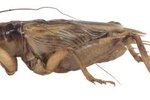
While young tarantulas molt more frequently than adults, arachnids of all ages shed their old exoskeletons to make room for the new. During their molt they become fragile little things. The slightest disturbance can result in a poor molt or serious injuries to your tarantula. Your eight-legged pal will likely show numerous signs that signify an impending molt.
Abdomen Baldness
New world tarantulas—meaning those that come from North and South America—have what are known as urticating hairs on their abdomens. When they feel threatened, they use their legs to flick those hairs to deter predators. Urticating hairs have serrated edges and can injure predators or even kill them. Some tarantulas feel threatened very easily and shed their hairs so often that a bald spot, light in color, forms on their abdomen. When they're getting ready to molt, that spot will turn darker.
Behavior
When your tarantula's getting ready to molt, you'll likely notice two prominent behavior changes: he won't eat and he'll seem less active than usual. If he doesn't eat the food you offer him after 24 hours, remove it from his enclosure. Continued refusal of food likely points to an imminent molt. If your tarantula is lethargic and thin or pacing his cage, something's wrong. Samuel Marshall, author of Tarantulas and Other Arachnids: Everything about Purchase, Care, Nutrition, Behavior and Housing, notes that likely culprits are poor humidity and parasites. If the humidity is not off, he suggests changing up the features of your arachnid's enclosure. If that doesn't work, make an appointment with an exotic vet.
Upside Down
If you look inside your tarantula's enclosure and see him upside down, don't panic. This is the last phase in the molting process, during which the old exoskeleton lifts off, enabling the new one to encase him. Almost all tarantulas turn themselves upside down when molting, and some spin a neat circular web to climb into to complete the molting process. Once the process ends—from minutes to several hours from when he turns over—he'll right himself.
Warnings
It's vital that you do not touch or disturb your tarantula in any way when he's on his back. It's extremely easy to cause harm or even kill him while he's in this phase. Never place food in his enclosure just before he molts, as he's molting or immediately after he molts. The American Tarantula Society suggests waiting roughly two weeks to feed adults, but notes that young spiderlings can be fed sooner. If your tarantula doesn't seem interested in food, remove it from his enclosure and offer it to him again in two days or so. If you feed him during any of the aforementioned times, his prey, especially crickets, could attack and kill him in his fragile state.
References
- Tarantulas and Other Arachnids: Everything about Purchase, Care, Nutrition, Behavior, and Housing; Samuel Marshall
- The Tarantula Keeper's Guide: Comprehensive Information on Care, Housing and Feeding; Stanley Schultz and Marguerite Schultz
- The American Tarantula Society: ATS Tarantula Care Sheet [PDF]
Photo Credits
-
Justin Sullivan/Getty Images News/Getty Images
Writer Bio
Located in Pittsburgh, Chris Miksen has been writing instructional articles on a wide range of topics for online publications since 2007. He currently owns and operates a vending business. Miksen has written a variety of technical and business articles throughout his writing career. He studied journalism at the Community College of Allegheny County.



